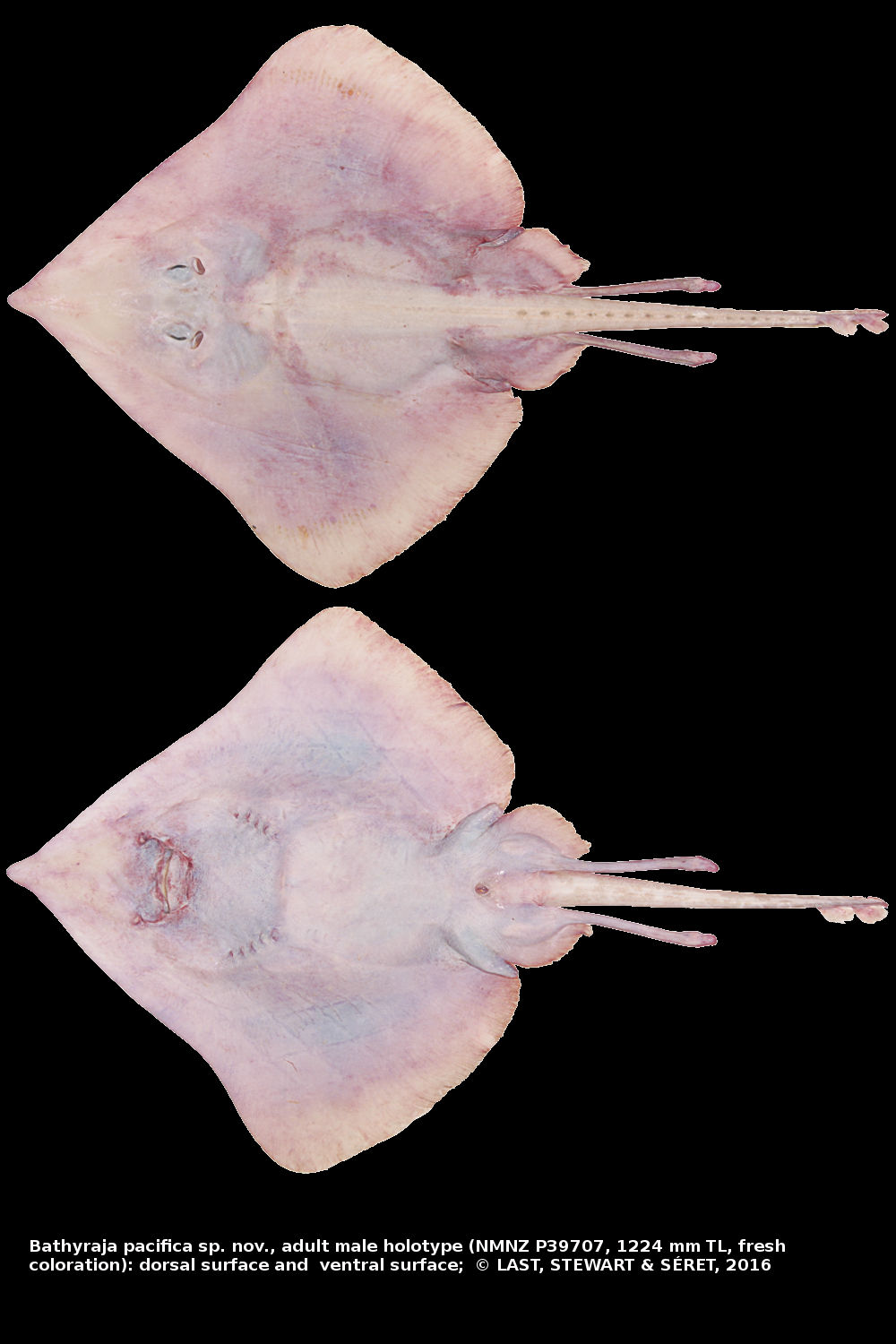Bathyraja pacifica
Last, Stewart & Séret, 2016
Pacific Blonde Skate
Classification: Elasmobranchii Rajiformes Arhynchobatidae
Reference of the original description
A new temperate deepwater skate of the genus Bathyraja (Rajoidei: Arhynchobatidae) from the South-West Pacific. Zootaxa, 4132(1), 107–117
A new temperate deepwater skate of the genus Bathyraja (Rajoidei: Arhynchobatidae) from the South-West Pacific. Zootaxa, 4132(1), 107–117
Description :
Citation: Bathyraja pacifica Last, Stewart & Séret, 2016: In: Database of modern sharks, rays and chimaeras, www.shark-references.com, World Wide Web electronic publication, Version 12/2025
Please send your images of "Bathyraja pacifica" to info@shark-references.com

Bathyraja pacifica sp. nov, adult male holotype (NMNZ P39707, 1224 mm TL, fresh coloration): dorsal surface and ventral surface; © Last, STEWART & Séret, 2016

Bathyraja pacifica sp. nov, adult male holotype (NMNZ P39707, 1224 mm TL, fresh coloration): dorsal surface and ventral surface; © Last, STEWART & Séret, 2016
Common names
 Pacific Blonde Skate
Pacific Blonde Skate
 Pacific Blonde Skate
Pacific Blonde Skate
Short Description
Original diagnosis after LAST, STEWART & SÉRET, 2016 [24270]: A large species of Bathyraja (to 122 cm TL) with the following combination of characters based on the holotype (unique specimen): disc strongly depressed and quadrangular with narrowly rounded apices, width 64% TL, 1.1 times its length; tail rather short, length 0.8 in distance from snout tip to rear of cloaca, its width 1.8 times height at its midlength, 1.5 times at first dorsal-fin origin; pre-upper jaw length 18% TL, 2.3 times internasal width; ventral head length 32% TL; snout long, broad, length 4.0 times interorbital width, supported by slender flexible median cartilage; snout angle 83°; mouth narrow 7% TL; orbit diameter 57% interorbital width; first dorsal-fin height 1.7 in its base length; procaudal length 2.3 times first dorsal-fin base length, 4.8 times caudal-fin length; dorsal disc almost entirely devoid of fine denticles; no thorns on disc, other than narrow alar thorn patches; tail with 16 (one lost) thorns in single median row; total pectoral radials 84–85; trunk centra 34; predorsal centra 105; total centra ~136; tooth rows in upper jaw 29; skin thin and almost entirely translucent white, no dark areas on body, sensory pores indistinct (not dark edged).
Original diagnosis after LAST, STEWART & SÉRET, 2016 [24270]: A large species of Bathyraja (to 122 cm TL) with the following combination of characters based on the holotype (unique specimen): disc strongly depressed and quadrangular with narrowly rounded apices, width 64% TL, 1.1 times its length; tail rather short, length 0.8 in distance from snout tip to rear of cloaca, its width 1.8 times height at its midlength, 1.5 times at first dorsal-fin origin; pre-upper jaw length 18% TL, 2.3 times internasal width; ventral head length 32% TL; snout long, broad, length 4.0 times interorbital width, supported by slender flexible median cartilage; snout angle 83°; mouth narrow 7% TL; orbit diameter 57% interorbital width; first dorsal-fin height 1.7 in its base length; procaudal length 2.3 times first dorsal-fin base length, 4.8 times caudal-fin length; dorsal disc almost entirely devoid of fine denticles; no thorns on disc, other than narrow alar thorn patches; tail with 16 (one lost) thorns in single median row; total pectoral radials 84–85; trunk centra 34; predorsal centra 105; total centra ~136; tooth rows in upper jaw 29; skin thin and almost entirely translucent white, no dark areas on body, sensory pores indistinct (not dark edged).
Dentition
lateral teeth of upper jaw exposed, not concealed by lip or lobe of nasal curtain. Teeth unicuspid, 29 rows in upper jaw, 29 rows in lower jaw; with slightly elevated subcircular bases; arranged in obvious longitudinal rows rather than in quincunx; cusps near middle of both jaws short, slender, pungent, strongly directed lingually in middle of upper jaw; slightly oblique (posterolaterally) at corner of jaws; [24270]
lateral teeth of upper jaw exposed, not concealed by lip or lobe of nasal curtain. Teeth unicuspid, 29 rows in upper jaw, 29 rows in lower jaw; with slightly elevated subcircular bases; arranged in obvious longitudinal rows rather than in quincunx; cusps near middle of both jaws short, slender, pungent, strongly directed lingually in middle of upper jaw; slightly oblique (posterolaterally) at corner of jaws; [24270]
Remarks
shark-references Species-ID=14604;
shark-references Species-ID=14604;

















